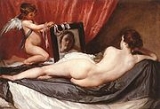
The Rokeby Venus
Encyclopedia

Diego Velázquez
Diego Rodríguez de Silva y Velázquez was a Spanish painter who was the leading artist in the court of King Philip IV. He was an individualistic artist of the contemporary Baroque period, important as a portrait artist...
(1599–1660), the leading artist of the Spanish Golden Age
Spanish Golden Age
The Spanish Golden Age is a period of flourishing in arts and literature in Spain, coinciding with the political rise and decline of the Spanish Habsburg dynasty. El Siglo de Oro does not imply precise dates and is usually considered to have lasted longer than an actual century...
. Completed between 1647 and 1651, and probably painted during the artist's visit to Italy, the work depicts the goddess Venus
Venus (mythology)
Venus is a Roman goddess principally associated with love, beauty, sex,sexual seduction and fertility, who played a key role in many Roman religious festivals and myths...
in a sensual pose, lying on a bed and looking into a mirror held by the Roman
Roman mythology
Roman mythology is the body of traditional stories pertaining to ancient Rome's legendary origins and religious system, as represented in the literature and visual arts of the Romans...
god of physical love, her son Cupid
Cupid
In Roman mythology, Cupid is the god of desire, affection and erotic love. He is the son of the goddess Venus and the god Mars. His Greek counterpart is Eros...
. The painting is in the National Gallery, London.
Numerous works, from the ancient to the baroque
Baroque
The Baroque is a period and the style that used exaggerated motion and clear, easily interpreted detail to produce drama, tension, exuberance, and grandeur in sculpture, painting, literature, dance, and music...
, have been cited as sources of inspiration for Velázquez. The nude Venuses of the Italian painters, such as Giorgione's
Giorgione
Giorgione was a Venetian painter of the High Renaissance in Venice, whose career was cut off by his death at a little over thirty. Giorgione is known for the elusive poetic quality of his work, though only about six surviving paintings are acknowledged for certain to be his work...
Sleeping Venus
Sleeping Venus (Giorgione)
The Sleeping Venus, also known as the Dresden Venus, is a painting by the Italian Renaissance master Giorgione, with, it is now generally accepted, the landscape and sky, by Titian, completed after Giorgione's death in 1510, as Vasari first noted...
(c. 1510) and Titian's
Titian
Tiziano Vecelli or Tiziano Vecellio Tiziano Vecelli or Tiziano Vecellio Tiziano Vecelli or Tiziano Vecellio (c. 1488/1490 – 27 August 1576 better known as Titian was an Italian painter, the most important member of the 16th-century Venetian school. He was born in Pieve di Cadore, near...
Venus of Urbino
Venus of Urbino
The Venus of Urbino is a 1538 oil painting by the Italian master Titian. It depicts a nude young woman, identified with the goddess Venus, reclining on a couch or bed in the sumptuous surroundings of a Renaissance palace. It hangs in the Galleria degli Uffizi in Florence. The figure's pose is based...
(1538), were the main precedents. In this work, Velázquez combined two established poses for Venus: recumbent on a couch or a bed, and gazing at a mirror. She is often described as looking at herself on the mirror, although this is physically impossible since viewers can see her face reflected in their direction. In a number of ways the painting represents a pictorial departure, through its central use of a mirror, and because it shows the body of Venus turned away from the observer of the painting.
The Rokeby Venus is the only surviving female nude by Velázquez. Nudes were extremely rare in seventeenth-century Spanish art, which was policed actively by members of the Spanish Inquisition
Spanish Inquisition
The Tribunal of the Holy Office of the Inquisition , commonly known as the Spanish Inquisition , was a tribunal established in 1480 by Catholic Monarchs Ferdinand II of Aragon and Isabella I of Castile. It was intended to maintain Catholic orthodoxy in their kingdoms, and to replace the Medieval...
. Despite this, nudes by foreign artists were keenly collected by the court circle, and this painting was hung in the houses of Spanish courtiers until 1813, when it was brought to England to hang in Rokeby Park
Rokeby Park
Rokeby Park is a country house in the Palladian style in Northern England. It is located close to the confluence of the River Tees and River Greta, close to Greta Bridge in what is now County Durham. It was historically located in the North Riding of Yorkshire...
, Yorkshire
Yorkshire
Yorkshire is a historic county of northern England and the largest in the United Kingdom. Because of its great size in comparison to other English counties, functions have been increasingly undertaken over time by its subdivisions, which have also been subject to periodic reform...
. In 1906, the painting was purchased by National Art Collections Fund for the National Gallery, London. Although it was attacked and badly damaged in 1914 by the suffragette
Women's suffrage
Women's suffrage or woman suffrage is the right of women to vote and to run for office. The expression is also used for the economic and political reform movement aimed at extending these rights to women and without any restrictions or qualifications such as property ownership, payment of tax, or...
Mary Richardson
Mary Richardson
Mary Raleigh Richardson was a Canadian suffragette active in the women's suffrage movement in the United Kingdom and later the head of the women's section of British Union of Fascists led by Sir Oswald Mosley....
, it soon was fully restored and returned to display.
Description
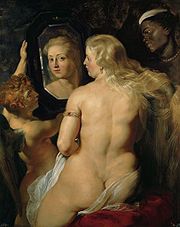
Roman mythology
Roman mythology is the body of traditional stories pertaining to ancient Rome's legendary origins and religious system, as represented in the literature and visual arts of the Romans...
goddess of love, beauty and fertility
Fertility
Fertility is the natural capability of producing offsprings. As a measure, "fertility rate" is the number of children born per couple, person or population. Fertility differs from fecundity, which is defined as the potential for reproduction...
reclining languidly on her bed, her back to the viewer—in Antiquity
Ancient history
Ancient history is the study of the written past from the beginning of recorded human history to the Early Middle Ages. The span of recorded history is roughly 5,000 years, with Cuneiform script, the oldest discovered form of coherent writing, from the protoliterate period around the 30th century BC...
, portrayal of Venus from a back view was a common visual and literary erotic motif—and her knees tucked. She is shown without the mythological paraphernalia normally included in depictions of the scene; jewellery, roses, and myrtle are all absent. Unlike most earlier portrayals of the goddess, which show her with blond hair, Velázquez's Venus is a brunette. The female figure can be identified as Venus because of the presence of her son, Cupid.
Venus gazes into a mirror held by Cupid, who is without his usual bow and arrows. When the work was first inventoried, it was described as "a nude woman", probably owing to its controversial nature.
Venus looks outward at the viewer of the painting through her reflected image in the mirror. However, the image is blurred and reveals only a vague reflection of her facial characteristics; the reflected image of the head is much larger than it would be in reality. The critic Natasha Wallace has speculated that Venus's indistinct face may be the key to the underlying meaning of the painting, in that "it is not intended as a specific female nude, nor even as a portrayal of Venus, but as an image of self-absorbed beauty." According to Wallace, "There is nothing spiritual about face or picture. The classical setting is an excuse for a very material aesthetic sexuality—not sex, as such, but an appreciation of the beauty that accompanies attraction."
Intertwining pink silk ribbons are draped over the mirror and curl over its frame. The ribbon's function has been the subject of much debate by art historians; suggestions include an allusion to the fetters
Fetters
Legcuffs, shackles, footcuffs, fetters or leg irons are a kind of physical restraint used on the feet or ankles to allow walking but prevent running and kicking. The term "fetter" shares a root with the word "foot"....
used by Cupid to bind lovers, that it was used to hang the mirror, and that it was used to blindfold Venus moments before. The critic Julián Gallego found Cupid's facial expression to be so melancholy that he interprets the ribbons as fetters binding the god to the image of Beauty, and gave the painting the title "Amor conquered by Beauty".
The folds of the bed sheets echo the goddess's physical form, and are rendered to emphasise the sweeping curves of her body. The composition mainly uses shades of red, white, and grey, which are used even in Venus's skin; although the effect of this simple colour scheme has been much praised, recent technical analysis has shown that the grey sheet was originally a "deep mauve", that has now faded. The luminescent colours used in Venus's skin, applied with "smooth, creamy, blended handling", contrast with the dark greys and black of the silk she is lying on, and with the brown of the wall behind her face.
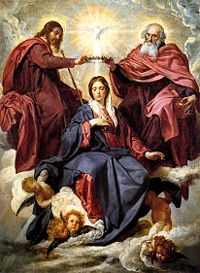
Royal Palace of Madrid
The Palacio Real de Madrid is the official residence of the King of Spain in the city of Madrid, but it is only used for state ceremonies. King Juan Carlos and the Royal Family do not reside in the palace, choosing instead the more modest Palacio de la Zarzuela on the outskirts of Madrid...
. A further one was recorded in the collection of Domingo Guerra Coronel. These records mention "a reclining Venus", Venus and Adonis, and a Psyche and Cupid.
Although the work is widely thought to have been painted from life, the identity of the model is subject to much speculation. In contemporary Spain it was acceptable for artists to employ male nude models for studies; however, the use of female nude models was frowned upon. The painting is believed to have been executed during one of Velázquez's visits to Rome, and Prater has observed that in Rome the artist "did indeed lead a life of considerable personal liberty that would have been consistent with the notion of using a live nude female model". It has been claimed that the painting depicts a mistress Velázquez is known to have had while in Italy, who is supposed to have borne his child. Others have claimed that the model is the same as in as a Coronation of the Virgin and Las Hilanderas
Las Hilanderas (Velázquez)
Las Hilanderas is a painting by the Spanish painter Diego Velázquez, dating from c. 1657 and housed in the Museo del Prado of Madrid, Spain. It was painted for Don Pedro de Arce, huntsman to King Philip IV...
, both in the Museo del Prado
Museo del Prado
The Museo del Prado is the main Spanish national art museum, located in central Madrid. It features one of the world's finest collections of European art, from the 12th century to the early 19th century, based on the former Spanish Royal Collection, and unquestionably the best single collection of...
, and other works.
The figures of both Venus and Cupid were significantly altered during the painting process, the result of the artist's corrections to the contours as initially painted. Pentimenti
Pentimento
A pentimento is an alteration in a painting, evidenced by traces of previous work, showing that the artist has changed his mind as to the composition during the process of painting...
can be seen in Venus's upraised arm, in the position of her left shoulder, and on her head. Infra-red reveals that she was originally shown more upright with her head turned to the left. An area on the left of the painting, extending from Venus's left foot to the left leg and foot of Cupid, is apparently unfinished, but this feature is seen in many other works by Velázquez and was probably deliberate. The painting was given a major cleaning and restoration in 1965–66, which showed it to be in good condition, and with very little paint added later by other artists, contrary to what some earlier writers had asserted.
Sources
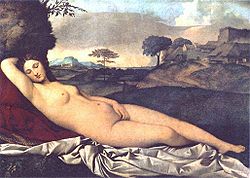
Girolamo Savoldo
Girolamo Savoldo, also called Girolamo da Brescia was an Italian High Renaissance painter.-Biography:...
and Lorenzo Lotto
Lorenzo Lotto
Lorenzo Lotto was a Northern Italian painter draughtsman and illustrator, traditionally placed in the Venetian school. He painted mainly altarpieces, religious subjects and portraits...
, who used mirrors as an active protagonist, as opposed to more than merely a prop or accessory in the pictorial space. Both Titian
Titian
Tiziano Vecelli or Tiziano Vecellio Tiziano Vecelli or Tiziano Vecellio Tiziano Vecelli or Tiziano Vecellio (c. 1488/1490 – 27 August 1576 better known as Titian was an Italian painter, the most important member of the 16th-century Venetian school. He was born in Pieve di Cadore, near...
and Peter Paul Rubens had already painted Venus looking into a mirror, and as both had had close ties to the Spanish court, their examples would have been familiar to Velázquez. However, "this girl with her small waist and jutting hip, does not resemble the fuller more rounded Italian nudes inspired by ancient sculpture".
One innovation, for a large single nude painting, of the Rokeby Venus comes in the fact that it shows a back view of its subject who is turned away from the viewer. There were precedents for this in prints
Old master print
An old master print is a work of art produced by a printing process within the Western tradition . A date of about 1830 is usually taken as marking the end of the period whose prints are covered by this term. The main techniques concerned are woodcut, engraving and etching, although there are...
by Giulio Campagnola
Giulio Campagnola
Giulio Campagnola was an Italian engraver and painter, whose few, rare, prints translated the rich Venetian Renaissance style of oil paintings of Giorgione and the early Titian into the medium of engraving; to further his exercises in gradations of tone, he also invented the stipple technique...
, Agostino Veneziano
Agostino Veneziano
Agostino Veneziano, whose real name was Agostino de' Musi, was an important and prolific Italian engraver of the Renaissance.-Life:...
, Hans Sebald Beham
Hans Sebald Beham
Hans Sebald Beham was a German printmaker who did his best work as an engraver, and was also a designer of woodcuts and a painter and miniaturist...
and Theodor de Bry, as well as classical sculptures known to Velázquez, of which casts were in Madrid. These were the Sleeping Ariadne now in the Pitti Palace, but then in Rome, of which Velázquez ordered a cast for the Royal collection in 1650–51, and the Borghese Hermaphroditus
Borghese Hermaphroditus
The Borghese Hermaphroditus is a type of marble sculpture depicting Hermaphroditus life size, reclining on a couch, with a form that is partly derived from ancient portrayals of Venus and other female nudes, and partly from contemporaneous feminised Hellenistic portrayals of Dionysus/Bacchus...
, a sleeping hermaphrodite
Hermaphrodite
In biology, a hermaphrodite is an organism that has reproductive organs normally associated with both male and female sexes.Many taxonomic groups of animals do not have separate sexes. In these groups, hermaphroditism is a normal condition, enabling a form of sexual reproduction in which both...
(picture to the right above), now in the Louvre
Louvre
The Musée du Louvre – in English, the Louvre Museum or simply the Louvre – is one of the world's largest museums, the most visited art museum in the world and a historic monument. A central landmark of Paris, it is located on the Right Bank of the Seine in the 1st arrondissement...
, of which a cast was sent to Madrid, and which also emphasises the curve from hip to waist. However, the combination of elements in Velázquez's composition was original.
The Rokeby Venus may have been intended as a pendant to a sixteenth-century Venetian
Venice
Venice is a city in northern Italy which is renowned for the beauty of its setting, its architecture and its artworks. It is the capital of the Veneto region...
painting of a recumbent Venus (which seems to have begun life as a Danaë
Danaë
In Greek mythology, Danaë was a daughter of King Acrisius of Argos and Eurydice of Argos. She was the mother of Perseus by Zeus. She was sometimes credited with founding the city of Ardea in Latium....
) in a landscape, in the same pose, but seen from the front. The two were certainly hung together for many years in Spain when in the collection of Gaspar Méndez de Haro, 7th Marquis of Carpio (1629–87); at what point they were initially paired is uncertain.
Nudes in 17th-century Spain
The portrayal of nudes was officially discouraged in 17th-century Spain. Works could be seized or repainting demanded by the Inquisition, and artists who painted licentious or immoral works were often excommunicated, fined, or banished from Spain for a year. However, within intellectual and aristocratic circles, the aims of art were believed to supersede questions of morality, and there were many, generally mythological, nudes in private collections..jpg)
Philip II of Spain
Philip II was King of Spain, Portugal, Naples, Sicily, and, while married to Mary I, King of England and Ireland. He was lord of the Seventeen Provinces from 1556 until 1581, holding various titles for the individual territories such as duke or count....
, and the Rubens he had commissioned himself. The Venus would be in such a room while in the collections of both Haro and Godoy. The court of Philip IV greatly "appreciated painting in general, and the nude in particular, but ... at the same time, exerted unparalleled pressure on artists to avoid the depiction of the naked human body."
The contemporary Spanish attitude toward paintings of nudes was unique in Europe. Although such works were appreciated by some connoisseurs and intellectuals within Spain, they were generally treated with suspicion. Low necklines were commonly worn by women during the period, but according to the art historian Zahira Veliz, "the codes of pictorial decorum would not easily permit a known lady to be painted in this way". For Spaniards of the 17th century, the issue of the nude in art was tied up with concepts of morality, power, and aesthetics. This attitude is reflected in the literature of the Spanish Golden Age
Spanish Golden Age
The Spanish Golden Age is a period of flourishing in arts and literature in Spain, coinciding with the political rise and decline of the Spanish Habsburg dynasty. El Siglo de Oro does not imply precise dates and is usually considered to have lasted longer than an actual century...
, in works such as Lope de Vega
Lope de Vega
Félix Arturo Lope de Vega y Carpio was a Spanish playwright and poet. He was one of the key figures in the Spanish Golden Century Baroque literature...
's play La quinta de Florencia, which features an aristocrat who commits rape after viewing a scantily clad figure in a mythological painting by Michelangelo
Michelangelo
Michelangelo di Lodovico Buonarroti Simoni , commonly known as Michelangelo, was an Italian Renaissance painter, sculptor, architect, poet, and engineer who exerted an unparalleled influence on the development of Western art...
.
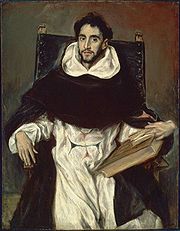
University of Salamanca
The University of Salamanca is a Spanish higher education institution, located in the town of Salamanca, west of Madrid. It was founded in 1134 and given the Royal charter of foundation by King Alfonso IX in 1218. It is the oldest founded university in Spain and the third oldest European...
and Alcalá
University of Alcalá
The University of Alcalá is a public university located in Alcalá de Henares, a city 35 km northeast of Madrid in Spain. Founded in 1499, it was moved in 1836 to Madrid. In 1977, the University was reopened in its same historical buildings...
, and other scholars on the abuse of lascivious and indecent figures and paintings, which are mortal sin to be painted, carved and displayed where they can be seen". The court was able to exert counter-pressure, and a piece by the famous poet and preacher Fray Hortensio Félix Paravicino
Hortensio Félix Paravicino
Hortensio Félix Paravicino y Arteaga was a Spanish preacher and poet from the noble house of Pallavicini....
, which proposed the destruction of all paintings of the nude, and was written to be included in the pamphlet, was never published. Paravicino was a connoisseur of painting, and therefore believed in its power: "the finest paintings are the greatest threat: burn the best of them". As his title shows, Braganza merely argued that such works should be kept from the view of a wider public, as was in fact mostly the practice in Spain.
In contrast, French art
French art
French art consists of the visual and plastic arts originating from the geographical area of France...
of the period often depicted women with low necklines and slender corsets; however, the mutilation by the French royal family of the Correggio depiction of Leda and the Swan
Leda and the Swan
Leda and the Swan is a motif from Greek mythology in which Zeus came to Leda in the form of a swan. According to later Greek mythology, Leda bore Helen and Polydeuces, children of Zeus, while at the same time bearing Castor and Clytemnestra, children of her husband Tyndareus, the King of Sparta. In...
and their apparent destruction of the famous Leonardo da Vinci
Leonardo da Vinci
Leonardo di ser Piero da Vinci was an Italian Renaissance polymath: painter, sculptor, architect, musician, scientist, mathematician, engineer, inventor, anatomist, geologist, cartographer, botanist and writer whose genius, perhaps more than that of any other figure, epitomized the Renaissance...
and Michelangelo
Michelangelo
Michelangelo di Lodovico Buonarroti Simoni , commonly known as Michelangelo, was an Italian Renaissance painter, sculptor, architect, poet, and engineer who exerted an unparalleled influence on the development of Western art...
paintings of the same subject, show that nudity could be controversial in France also. In northern Europe it was seen as acceptable to portray artfully draped nudes. Examples include Rubens's Minerva Victrix, of 1622–25, which shows Marie de' Medici
Marie de' Medici
Marie de Médicis , Italian Maria de' Medici, was queen consort of France, as the second wife of King Henry IV of France, of the House of Bourbon. She herself was a member of the wealthy and powerful House of Medici...
with an uncovered breast, and Anthony van Dyck
Anthony van Dyck
Sir Anthony van Dyck was a Flemish Baroque artist who became the leading court painter in England. He is most famous for his portraits of Charles I of England and his family and court, painted with a relaxed elegance that was to be the dominant influence on English portrait-painting for the next...
's 1620 painting, The Duke and Duchess of Buckingham as Venus and Adonis.
In 17th-century Spanish art, even in the depiction of sibyl
Sibyl
The word Sibyl comes from the Greek word σίβυλλα sibylla, meaning prophetess. The earliest oracular seeresses known as the sibyls of antiquity, "who admittedly are known only through legend" prophesied at certain holy sites, under the divine influence of a deity, originally— at Delphi and...
s, nymphs, and goddesses, the female form was always chastely covered. No painting from the 1630s or 1640s, whether in the genre, portrait, or history
History painting
History painting is a genre in painting defined by subject matter rather than an artistic style, depicting a moment in a narrative story, rather than a static subject such as a portrait...
format, shows a Spanish female with her breasts exposed; even uncovered arms were only rarely shown. In 1997, the art historian Peter Cherry suggested that Velázquez sought to overcome the contemporary requirement for modesty by portraying Venus from the back. Even in the mid-18th century, an English artist who made a drawing of the Venus when it was in the collection of the Dukes of Alba noted it was "not hung up, owing to the subject".
Another attitude to the issue was shown by Morritt, who wrote to Sir Walter Scott of his "fine painting of Venus' backside", which he hung above his main fireplace, so that "the ladies may avert their downcast eyes without difficulty and connoisseurs steal a glance without drawing the said posterior into the company".
Provenance
The Rokeby Venus was long held to be one of Velázquez's final works. In 1951, it was found recorded in an inventory of June 1, 1651 from the collection of Gaspar Méndez de Haro, 7th Marquis of Carpio, a close associate of Philip IV of SpainPhilip IV of Spain
Philip IV was King of Spain between 1621 and 1665, sovereign of the Spanish Netherlands, and King of Portugal until 1640...
. Haro was the great-nephew of Velázquez's first patron, the Count-Duke of Olivares
Gaspar de Guzmán, Count-Duke of Olivares
Don Gaspar de Guzmán y Pimentel Ribera y Velasco de Tovar, Count-Duke of Olivares and Duke of San Lúcar la Mayor , was a Spanish royal favourite of Philip IV and minister. As prime minister from 1621 to 1643, he over-exerted Spain in foreign affairs and unsuccessfully attempted domestic reform...
, and a notorious libertine
Libertine
A libertine is one devoid of most moral restraints, which are seen as unnecessary or undesirable, especially one who ignores or even spurns accepted morals and forms of behavior sanctified by the larger society. Libertines, also known as rakes, placed value on physical pleasures, meaning those...
. According to the art historian Dawson Carr, Haro "loved paintings almost as much as he loved women", and "even his panegyrists lamented his excessive taste for lower-class women during his youth". For these reasons it seemed likely that he would have commissioned the painting. However, in 2001 the art historian Ángel Aterido discovered that the painting had first belonged to the Madrid art dealer and painter Domingo Guerra Coronel, and was sold to Haro in 1652 following Coronel's death the previous year. Coronel's ownership of the painting raises a number of questions: how and when it came into Coronel's possession, and why Velázquez's name was omitted from Coronel's inventory. The art critic Javier Portús has suggested that the omission may have been due to the painting's portrayal of a female nude, "a type of work which was carefully supervised and whose dissemination was considered problematic".

Las Meninas
Las Meninas is a 1656 painting by Diego Velázquez, the leading artist of the Spanish Golden Age, in the Museo del Prado in Madrid. The work's complex and enigmatic composition raises questions about reality and illusion, and creates an uncertain relationship between the viewer and the figures...
.
The painting passed from Haro into the collection of his daughter Catalina de Haro y Guzmán, the eighth Marchioness of Carpio, and her husband, Francisco Álvarez de Toledo, the tenth Duke of Alba. In 1802, Charles IV of Spain
Charles IV of Spain
Charles IV was King of Spain from 14 December 1788 until his abdication on 19 March 1808.-Early life:...
ordered the family to sell the painting (with other works) to Manuel de Godoy
Manuel de Godoy
Don Manuel Francisco Domingo de Godoy y Álvarez de Faria, de los Ríos y Sánchez-Zarzosa, also Manuel de Godoy y Álvarez de Faria de los Ríos Sánchez Zarzosa , was Prime Minister of Spain from 1792 to 1797 and from 1801 to 1808...
, his favourite
Favourite
A favourite , or favorite , was the intimate companion of a ruler or other important person. In medieval and Early Modern Europe, among other times and places, the term is used of individuals delegated significant political power by a ruler...
and chief minister. He hung it alongside two masterpieces by Francisco Goya
Francisco Goya
Francisco José de Goya y Lucientes was a Spanish romantic painter and printmaker regarded both as the last of the Old Masters and the first of the moderns. Goya was a court painter to the Spanish Crown, and through his works was both a commentator on and chronicler of his era...
that he may have commissioned himself, The Nude Maja
La Maja Desnuda
La maja desnuda is an oil on canvas painting by the Spanish painter Francisco Goya , portraying a nude woman reclining on a bed of pillows. It was executed some time between 1797 and 1800, and is sometimes said to be the first clear depiction of female pubic hair in a large Western painting...
and The Clothed Maja
La Maja Vestida
La maja vestida is a painting by Spanish painter Francisco de Goya between 1798 and 1805. It is a clothed version of La maja desnuda and is exhibited next to it in the same room at the Prado Museum in Madrid...
. These bear obvious compositional similarities with Velázquez's Venus, although unlike Velázquez, Goya clearly painted his nude in a calculated attempt to provoke shame and disgust in the relatively unenlightened climate of 18th-century Spain.
Venus was brought to England in 1813, where it was purchased by John Morritt for £500 (£ in ), and on the advice of his friend Sir Thomas Lawrence
Thomas Lawrence
Thomas Lawrence may refer to:*Sir Thomas Lawrence, British artist, President of Royal Academy*Thomas Lawrence , mayor of colonial Philadelphia*T. E. Lawrence, "Lawrence of Arabia"*Thomas Lawrence , U.S. politician...
. Morritt hung it in his house at Rokeby Park, Yorkshire—thus the painting's popular name. In 1906, the painting was acquired for the National Gallery by the newly created National Art Collections Fund, its first campaigning triumph. King Edward VII
Edward VII of the United Kingdom
Edward VII was King of the United Kingdom and the British Dominions and Emperor of India from 22 January 1901 until his death in 1910...
greatly admired the painting, and anonymously provided £8,000 (£ in ) towards its purchase, and became Patron of the Fund thereafter.
Legacy
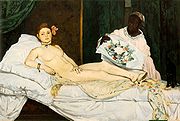
Royal Academy
The Royal Academy of Arts is an art institution based in Burlington House on Piccadilly, London. The Royal Academy of Arts has a unique position in being an independent, privately funded institution led by eminent artists and architects whose purpose is to promote the creation, enjoyment and...
in London, and in 1905 at Messrs. Agnews, the dealers who had bought it from Morritt. From 1906 it was highly visible in the National Gallery and became well-known globally through reproductions. The general influence of the painting was therefore long delayed, although individual artists would have been able to see it on occasion throughout its history.
Velázquez's portrait is a staging of a private moment of intimacy and a dramatic departure from the classical depictions of sleep and intimacy found in works from antiquity and Venetian art that portray Venus. However, the simplicity with which Velázquez displays the female nude—without jewellery or any of the goddess's usual accessories—was echoed in later nude studies by Ingres
Jean Auguste Dominique Ingres
Jean-Auguste-Dominique Ingres was a French Neoclassical painter. Although he considered himself to be a painter of history in the tradition of Nicolas Poussin and Jacques-Louis David, by the end of his life it was Ingres's portraits, both painted and drawn, that were recognized as his greatest...
, Manet
Édouard Manet
Édouard Manet was a French painter. One of the first 19th-century artists to approach modern-life subjects, he was a pivotal figure in the transition from Realism to Impressionism....
, and Baudry
Paul-Jacques-Aimé Baudry
Paul-Jacques-Aimé Baudry was a French painter.-Biography:He studied under Michel Martin Drolling and carried off the Prix de Rome in 1850 by his picture of Zenobia found on the banks of the Araxes...
, among others. In addition, Velázquez's depiction of Venus as a reclining nude viewed from the rear was a rarity before that time, although the pose has been painted by many later artists. Manet, in his stark female portrayal Olympia
Olympia (painting)
Olympia is an oil on canvas painting by Édouard Manet. Painted in 1863, it measures 130.5 by 190 centimetres . The nation of France acquired the painting in 1890 with a public subscription organized by Claude Monet...
, paraphrased the Rokeby Venus in pose and by suggesting the persona of a real woman rather than an ethereal goddess. Olympia shocked the Paris
Paris
Paris is the capital and largest city in France, situated on the river Seine, in northern France, at the heart of the Île-de-France region...
ian art world when it was first exhibited in 1863. Olympia gazes directly out at the viewer, as does Velázquez's Venus, only through the reflection of the mirror.
Vandalism, 1914
On March 10, 1914, the militant suffragetteSuffragette
"Suffragette" is a term coined by the Daily Mail newspaper as a derogatory label for members of the late 19th and early 20th century movement for women's suffrage in the United Kingdom, in particular members of the Women's Social and Political Union...
Mary Richardson
Mary Richardson
Mary Raleigh Richardson was a Canadian suffragette active in the women's suffrage movement in the United Kingdom and later the head of the women's section of British Union of Fascists led by Sir Oswald Mosley....
walked into the National Gallery and attacked Velázquez's canvas with a meat cleaver. Her action was ostensibly provoked by the arrest of fellow suffragette Emmeline Pankhurst
Emmeline Pankhurst
Emmeline Pankhurst was a British political activist and leader of the British suffragette movement which helped women win the right to vote...
the previous day, although there had been earlier warnings of a planned suffragette attack on the collection. Richardson left seven slashes on the painting, particularly causing damage to the area between the figure's shoulders. However, all were successfully repaired by the National Gallery's chief restorer Helmut Ruhemann.
Richardson was sentenced to six months' imprisonment, the maximum allowed for destruction of an artwork. In a statement to the Women's Social and Political Union
Women's Social and Political Union
The Women's Social and Political Union was the leading militant organisation campaigning for Women's suffrage in the United Kingdom...
shortly afterwards, Richardson explained, "I have tried to destroy the picture of the most beautiful woman in mythological history as a protest against the Government for destroying Mrs. Pankhurst, who is the most beautiful character in modern history." She added in a 1952 interview that she didn't like "the way men visitors gaped at it all day long".
The feminist writer Lynda Nead observed, "The incident has come to symbolize a particular perception of feminist attitudes towards the female nude; in a sense, it has come to represent a specific stereotypical image of feminism more generally." Contemporary reports of the incident reveal that the picture was not widely seen as mere artwork. Journalists tended to assess the attack in terms of a murder (Richardson was nicknamed "Slasher Mary"), and used words that conjured wounds inflicted on an actual female body, rather than on a pictorial representation of a female body. The Times, in an article that contained factual inaccuracies as to the painting's provenance, described a "cruel wound in the neck", as well as incisions to the shoulders and back.

